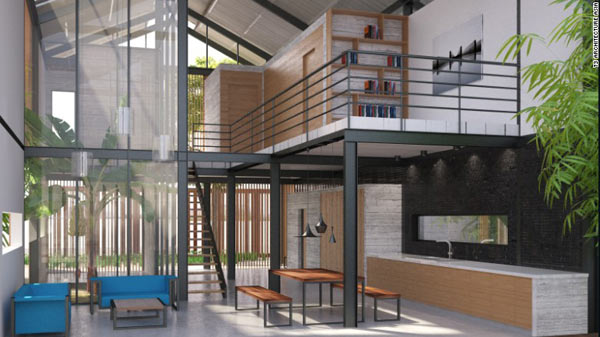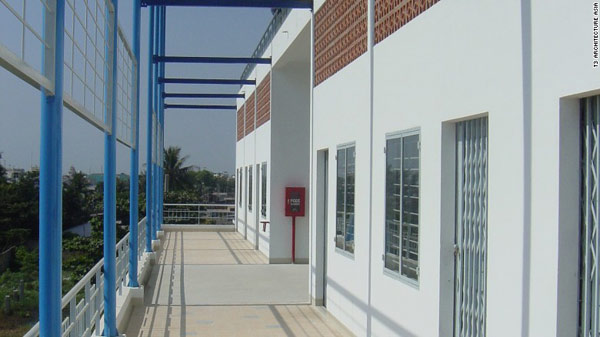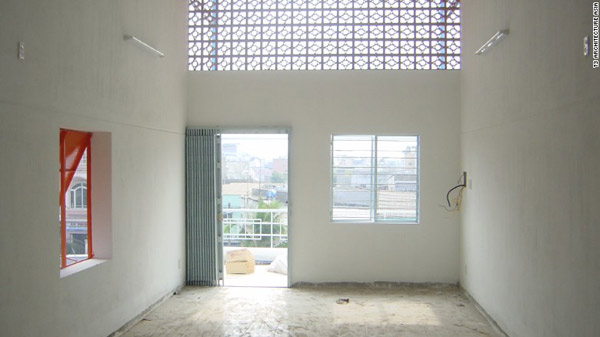当前位置: Language Tips> 双语新闻
The end of air conditioning? Asia architects use green solutions to cool buildings
在又湿又热的热带城市,没有空调的大楼简直是不可想象的,但并不是每个人都可以支付得起天天开空调的费用。为此亚洲建筑师设计出了一种不用空调也凉爽的建筑,一起来看看。

Spend five minutes in humid Ho Chi Minh City and you'll probably be running for cover into the nearest air-conditioned refuge.
在闷热的胡志明市待上5分钟,你很可能会迫不及待地跑到最近的一个有空调的地方避暑。
In the Vietnamese city -- and many developing subtropical countries across Asia, such as Indonesia and the Philippines -- air conditioning (AC) is increasingly being considered a necessity.
在越南的这座城市,还有亚洲很多亚热带的发展中国家,比如印尼和菲律宾,空调越来越被视为是必需品。
But one architecture firm is advocating a different way to keep cool.
然而一家建筑公司正在倡导一种保持凉爽的不同方式。
T3 Architecture Asia, which has offices in Vietnam and France, specializes in back-to-basics "bioclimatic architecture", which it says could make energy-guzzling AC units redundant.
在越南和法国设有办事处的T3亚洲建筑公司主业是回归本原的“生物气候建筑”,该公司声称这种建筑会让大量消耗能源的空调变得多余。

By harnessing the local topography, climate, and vegetation, as well as cleverly manipulating a building's orientation, the firm can naturally create a comfortable indoor climate.
通过巧妙地利用一座建筑的朝向,以及合理利用本地的地形、气候、植被,该公司可以自然地营造出舒适的室内气候条件。
Charles Gallavardin, director of T3 Architecture Asia, first forayed into bioclimatic architecture in 2005. In cooperation with the World Bank, he built an affordable apartment building in Ho Chi Minh City, which houses 350 families in an impoverished neighborhood where AC bills were to be avoided.
T3亚洲建筑公司的经理查尔斯•嘎拉瓦丁2005年首次涉足生物气候建筑。他在胡志明市和世界银行合力建造了一座经济适用房大楼,这座可容纳350户家庭的大楼建在负担不起空调费用的贫民区。
"You don't need to spend money on air conditioning, even in a hot climate like Ho Chi Minh, as long as your building is well designed," Gallavardin tells CNN.
嘎拉瓦丁告诉CNN说:“只要建筑设计得好,即使是在胡志明市这样炎热的地方,你也不需要在空调上花钱。”
Covered open-air corridors, ventilated roofs, fiber-glass insulation and the use of natural materials meant the Ho Chi Minh City units offered both natural light and ventilation.
封闭式露天走廊、通风屋顶、玻璃纤维隔热墙以及天然材料的使用意味着胡志明市的这座建筑拥有良好的自然光线和通风条件。

"We try to avoid big glass facades facing east or west, because that would make the building like an oven in a tropical climate," he says.
他表示:“我们努力避免让大面玻璃墙朝东或朝西,因为这样会让热带气候中的建筑变成一个大火炉。”
"If you work with the main wind stream and have smart sun protection, you can do it -- you really can design buildings that need no air conditioning in a hot place like Vietnam."
“如果你利用好了主要通风口,并巧妙地做好防晒,你就可以在越南如此炎热的地方设计出不用空调也凉爽的建筑。”
Gallavardin explains that a typical bioclimatic T3 building is naturally about 41 Fahrenheit (22 Celsius) cooler than the outside temperature, with natural ventilation and the odd ceiling fan doing the rest of the work.
嘎拉瓦丁解释说,典型的T3生物气候建筑内的自然温度比室外温度低41华氏度(22摄氏度),只需要自然通风和几个吊顶电风扇就能保持凉爽。

Since that first project, Gallavardin has built several luxury bioclimatic hotels in Cambodia and Myanmar, a concept restaurant in Ho Chi Minh City, and even his own green office for the T3 team.
自从这第一个项目之后,嘎拉瓦丁已经在柬埔寨和缅甸建造了几个豪华生物气候酒店,在胡志明市建造了一个概念餐厅,甚至还为T3团队建造了自己的绿色办公楼。
Other architects are also experimenting with this style of building.
其他建筑师也在尝试这种风格的建筑。
In Indonesia, Andyrahman Architect's Biophilic Boarding House was shortlisted in the World Architecture Festival's Building of the Year 2016 competition, praised for its perforated walls that help the building stay cool in tropical Surabaya, a congested port city in East Java.
在印尼,安迪拉曼建筑公司的亲生物寄宿公寓入围了2016世界建筑节年度建筑大赛候选名单。该公寓位于热带地区的泗水市,是东爪哇一个拥挤的港口城市。这所公寓凭借多孔墙让大楼保持凉爽而受到赞赏。
In China, American architecture firm Perkins & Will took a bioclimatic approach to the new Shanghai Natural History Museum -- while the building provides air-conditioning in gallery areas to protect the artwork from humidity, it also has automated windows and skylights to naturally ventilate public areas.
在中国,美国建筑公司帕金斯威尔事务所采用生物气候学方法设计了新的上海自然历史博物馆,尽管博物馆在画廊区开空调以保护艺术品不受潮,但是博物馆也设有自动窗户和天窗,让公共区域可以自然通风。
The museum saves 15% on energy consumption compared to a standard-design museum.
相比标准设计的博物馆,新上海自然历史博物馆消耗的能源节省了15%。
英文来源:CNN
翻译&编辑:丹妮
上一篇 : 明星为戏增肥又减脂 那些折腾到底值不值
下一篇 :
关注和订阅

电话:8610-84883645
传真:8610-84883500
Email: languagetips@chinadaily.com.cn